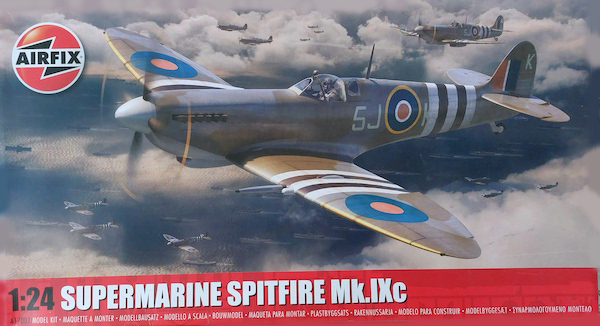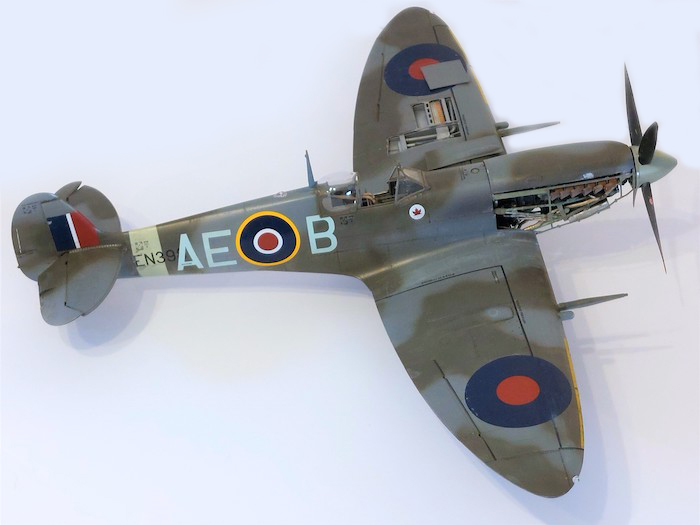
Full Review with Rob Ruscoe
Just before we get started, here’s a quick look at how it all turned out…

Many words have been used to describe the Spitfire – Iconic, Legendary, Classic, and even Beautiful. All these appellations are well deserved of course. Born into a time of military uncertainty, the Spitfire, along with its stablemate, the equally iconic Hawker Hurricane, arrived in service in sufficient numbers just in time to enable the RAF to deter an invasion of this green and pleasant isle of ours.
Adding to the legend was the fact that the chief designer of the aircraft, Reginald Mitchell, never saw his creation enter service, having succumbed to cancer in June 1937, just 15 months after the prototype first flew.
It was left to the new chief, the largely unsung Joe Smith, to develop the aircraft throughout the war years and beyond. The superb basic design of the airframe enabled Smith to keep the Spitfire in the forefront of fighter combat right to the end of the war. I remember reading in ‘Spitfire: A Test Pilot’s story’ by Jeffrey Quill, the amazing fact that the last mark, the Spitfire 24, was the same all up weight as the Mark I – if it was carrying twenty passengers!
In August 1941 the introduction into the Luftwaffe of the FW190 started to give the Spit Vs then in service, a very hard time. Rolls Royce was in the process of developing the 60 series of Merlin engine with a two-stage supercharger which gave a large increase of power over a much greater altitude range. Joe Smith was developing a new cleaned up airframe, the MkVIII, to accept the new engine but a change on the production line at this point would have taken too much time to bring this into service. Supermarine therefore proposed fitting the new engine into the existing MkV airframe with minimum modifications. This stopgap aircraft could be brought into service relatively quickly to help the beleaguered Squadrons on the front line combat the Focke Wulf fighter.
So was born the MkIX. When the first aircraft entered service, the FW190 pilots were given a rude shock as they couldn’t differentiate between the MkV and the new MkIX which had a much improved performance. The stopgap IX, in fact, went on to be produced in the largest numbers if you count the Packard Merlin powered MkXVI.
The Kit…
Having built all of the recent 1:24 toolings from Airfix; namely the Mosquito, both Typhoon versions and more recently, the Hellcat, I was looking forward to their next offering. I must say I was disappointed when they announced it was to be yet another Spitfire! Looking at it from Airfix’s perspective, I suppose any Spitfire kit is going to sell in large numbers. Thinking even more, the only other 1:24 offerings besides the original vintage Airfix Mk.IIa, is the Trumpeter Mk.V and VI. These were among the earlier efforts from the Chinese manufacturer and, although nice to build, the amount of scratch building necessary to correct the horrible mistakes, makes them a real challenge. Even then the inaccuracies in shape, particularly the nose section, make them a big challenge. In contrast, their later Hurricane kits are excellent. This is also the first Mk.IX in the big scale so I didn’t need much excuse to get one. I’m glad I did!
The kit comes in a fairly large and robust top opening box (wish Revell would take note!). It is absolutely packed with styrene – lots and lots of sprues with all the parts exhibiting zero flash and very, very nice detail. Panel lines and rivet detail look perfect except maybe, for the wing leading edges which are a lot smoother on the real thing. This is a matter of a few minutes light sanding to correct. Like the Typhoon and Hellcat, the slight ‘oil canning’ on the wings and fuselage, evident on all riveted stressed skin, is also nicely reproduced. The clear parts are indeed, crystal clear and a nice touch is the inclusion of two sliding canopies. Because of the limitations of the moulding process, the bulged canopy on the Spitfire cannot be reproduced accurately without leaving a thin seam line down its length. Therefore this will need sanding off and then the clarity restored with fine wet and dry and a polishing agent (I used toothpaste on mine). If you don’t feel confident about doing this, then Airfix thoughtfully provide a slightly less bulged option without a seam. To be honest, placing the two canopies side by side does not reveal too much difference and on the model, I would be hard pushed to notice the seamless version is slightly lower.
Also in the box is a large decal sheet covering five different options; three British, one USAAF and one in French markings. There are slight differences between these aircraft and the optional parts are detailed in the instructions. You will have to decide early on in the build which option you want as these parts options begin at stage 29 of a 243 stage build. The instructions are of Airfix’s current, clear style and is an A4 sized booklet. Three separate double colour profile sheets are provided for the five options and a generic decal placement diagram. As usual, colour call outs are only for Hornby’s own Humbrol brand. There is also a detailed colour swatch diagram for detail colours on page three of the instruction booklet with, overleaf, a cockpit decal placement diagram which refers to the relevant stages of construction. Nice! Using this diagram, I marked with an asterisk, the stages in the instructions where I needed to apply decals. This way I hoped not to miss any.